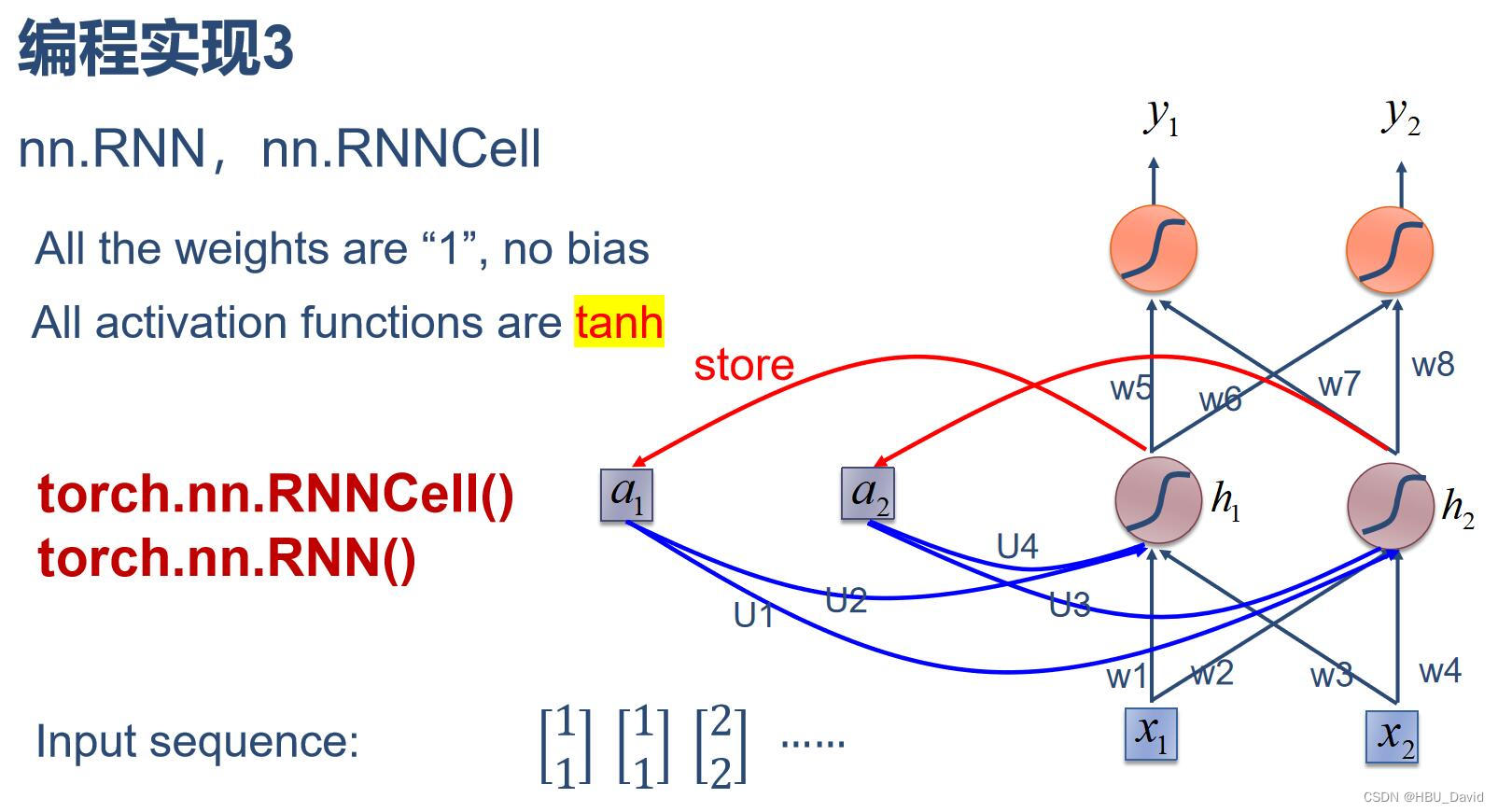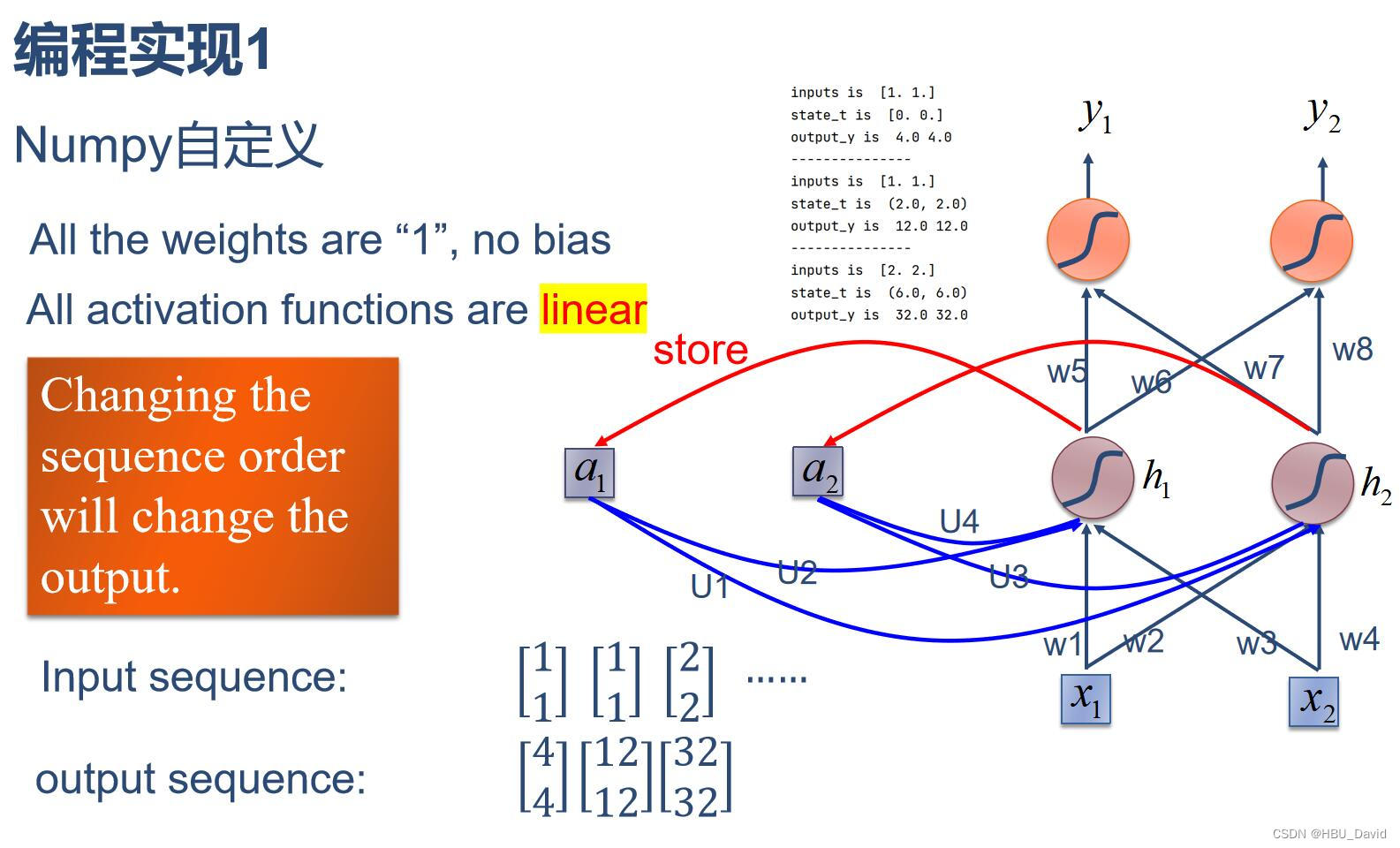import numpy as np
inputs = np.array([[1., 1.],
[1., 1.],
[2., 2.]]) # 初始化输入序列
print('inputs is ', inputs)
state_t = np.zeros(2, ) # 初始化存储器
print('state_t is ', state_t)
w1, w2, w3, w4, w5, w6, w7, w8 = 1., 1., 1., 1., 1., 1., 1., 1.
U1, U2, U3, U4 = 1., 1., 1., 1.
print('--------------------------------------')
for input_t in inputs:
print('inputs is ', input_t)
print('state_t is ', state_t)
in_h1 = np.dot([w1, w3], input_t) + np.dot([U2, U4], state_t)
in_h2 = np.dot([w2, w4], input_t) + np.dot([U1, U3], state_t)
state_t = in_h1, in_h2
output_y1 = np.dot([w5, w7], [in_h1, in_h2])
output_y2 = np.dot([w6, w8], [in_h1, in_h2])
print('output_y is ', output_y1, output_y2)
print('---------------')
运行结果:
inputs is [[1. 1.]
[1. 1.]
[2. 2.]]
state_t is [0. 0.]
--------------------------------------
inputs is [1. 1.]
state_t is [0. 0.]
output_y is 4.0 4.0
---------------
inputs is [1. 1.]
state_t is (2.0, 2.0)
output_y is 12.0 12.0
---------------
inputs is [2. 2.]
state_t is (6.0, 6.0)
output_y is 32.0 32.0
---------------
Process finished with exit code 0
2. 在1的基础上,增加激活函数tanh
import numpy as np
inputs = np.array([[1., 1.],
[1., 1.],
[2., 2.]]) # 初始化输入序列
print('inputs is ', inputs)
state_t = np.zeros(2, ) # 初始化存储器
print('state_t is ', state_t)
w1, w2, w3, w4, w5, w6, w7, w8 = 1., 1., 1., 1., 1., 1., 1., 1.
U1, U2, U3, U4 = 1., 1., 1., 1.
print('--------------------------------------')
for input_t in inputs:
print('inputs is ', input_t)
print('state_t is ', state_t)
in_h1 = np.tanh(np.dot([w1, w3], input_t) + np.dot([U2, U4], state_t))
in_h2 = np.tanh(np.dot([w2, w4], input_t) + np.dot([U1, U3], state_t))
state_t = in_h1, in_h2
output_y1 = np.dot([w5, w7], [in_h1, in_h2])
output_y2 = np.dot([w6, w8], [in_h1, in_h2])
print('output_y is ', output_y1, output_y2)
print('---------------')
运行结果:
inputs is [[1. 1.]
[1. 1.]
[2. 2.]]
state_t is [0. 0.]
--------------------------------------
inputs is [1. 1.]
state_t is [0. 0.]
output_y is 1.9280551601516338 1.9280551601516338
---------------
inputs is [1. 1.]
state_t is (0.9640275800758169, 0.9640275800758169)
output_y is 1.9984510891336251 1.9984510891336251
---------------
inputs is [2. 2.]
state_t is (0.9992255445668126, 0.9992255445668126)
output_y is 1.9999753470497836 1.9999753470497836
---------------
————————————————
版权声明:本文为CSDN博主「白小码i」的原创文章,遵循CC 4.0 BY-SA版权协议,转载请附上原文出处链接及本声明。
原文链接:https://blog.csdn.net/qq_52551768/article/details/127831761
3. 分别使用nn.RNNCell、nn.RNN实现SRN
import torch
batch_size = 1
seq_len = 3 # 序列长度
input_size = 2 # 输入序列维度
hidden_size = 2 # 隐藏层维度
output_size = 2 # 输出层维度
# RNNCell
cell = torch.nn.RNNCell(input_size=input_size, hidden_size=hidden_size)
# 初始化参数 https://zhuanlan.zhihu.com/p/342012463
for name, param in cell.named_parameters():
if name.startswith("weight"):
torch.nn.init.ones_(param)
else:
torch.nn.init.zeros_(param)
# 线性层
liner = torch.nn.Linear(hidden_size, output_size)
liner.weight.data = torch.Tensor([[1, 1], [1, 1]])
liner.bias.data = torch.Tensor([0.0])
seq = torch.Tensor([[[1, 1]],
[[1, 1]],
[[2, 2]]])
hidden = torch.zeros(batch_size, hidden_size)
output = torch.zeros(batch_size, output_size)
for idx, input in enumerate(seq):
print('=' * 20, idx, '=' * 20)
print('Input :', input)
print('hidden :', hidden)
hidden = cell(input, hidden)
output = liner(hidden)
print('output :', output)
运行结果:
==================== 0 ====================
Input : tensor([[1., 1.]])
hidden : tensor([[0., 0.]])
output : tensor([[1.9281, 1.9281]], grad_fn=<AddmmBackward0>)
==================== 1 ====================
Input : tensor([[1., 1.]])
hidden : tensor([[0.9640, 0.9640]], grad_fn=<TanhBackward0>)
output : tensor([[1.9985, 1.9985]], grad_fn=<AddmmBackward0>)
==================== 2 ====================
Input :











 最低0.47元/天 解锁文章
最低0.47元/天 解锁文章















 7177
7177

 被折叠的 条评论
为什么被折叠?
被折叠的 条评论
为什么被折叠?








